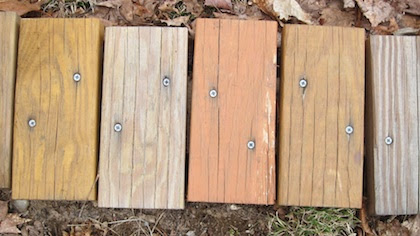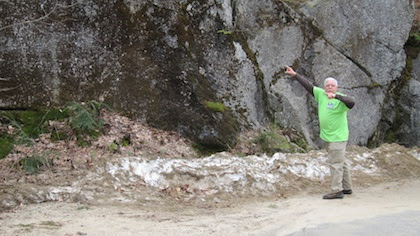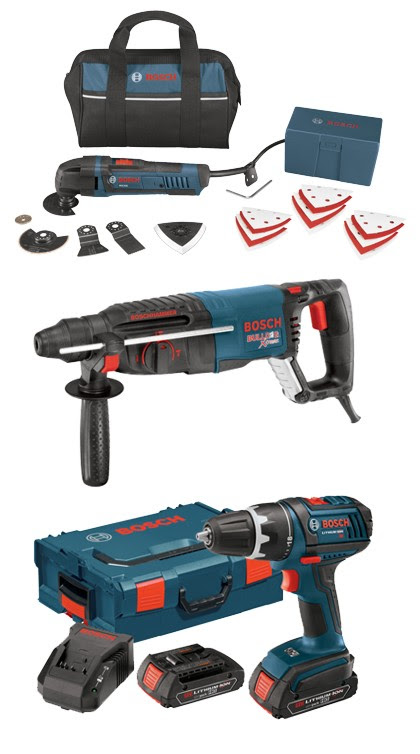April 29, 2014 AsktheBuilder Newsletter & Tips
While you're reading this, assuming you do so within an hour or two of it landing in your inbox, I'll be with my son driving towards Lynn's house in Maryland. Lynn was the Grand Prize winner in the Treasure Hunt.
On Wednesday, I'm going to tackle at least one project for her, and maybe two if the weather cooperates. We'll be taping video, so you'll get to see what we do.
As I travel back to New Hampshire, it turns out it's not much of a detour to stop by Art's house on the NJ shore. Art was a finalist in the Treasure Hunt too. I hope to be able to tape at least one or two videos there for your viewing enjoyment. Watch for them next week if all goes well.
While I'm gone, the snow at my house will finally disappear. Look at the difference one week makes! Remember last week when the snow was chest high on me? I'm pointing the direction I'll be driving tomorrow.
Kathy will be monitoring the pile and note the day it finally disappears. I'm going to be REALLY CLOSE on my guess!! I guessed May 2nd. Pure luck. It might be on Saturday, May 3rd.
The BOSCH Tools and Accessories Game!
You told me after the Treasure Hunt you wanted more games, you wanted to know more about power tools and you wanted to WIN power tools.
BOOM! You get all three today! Look at the three prizes Bosch is offering up for the game today! You could be one of the winners!
If you want a chance to win the tools and accessories in the above image, you just have to play a very simple game.
It's FREE to play, there's NO obligation, it's fun and challenging, and I GUARANTEE you that some of the answers to the questions will make you laugh out loud.
CLICK HERE to play.
Once on that page, all you have to do is look at a little image snippet. You'll then visit THREE separate pages at the Bosch website.
Study all the photos and text on all three pages.
You then just answer the easy multiple-choice questions and click the Bosch Rocks button.
The game will last one week only. PLAY IT NOW or you may forget!
Roots in a Sewer Line
Jeff, a fellow ham radio operator - N2HPO - contacted me after last week's newsletter.
"As for the crystal root stuff, I have a 90-year-old house connected to a city sewer and trees in the front yard. I have lived here since 1983 and about two years after moving in bought a General sewer cleaner, a large one. I find if I don't regularly use the crystals I have more problems, or am I imagining that? Once there is a blockage they do not work and it is time for the machine and some manual labor. I would appreciate your thoughts and advice."
Here's what I sent back to Jeff:
Jeff,
You want to stop tree roots PERMANENTLY in a sewer line? The method I demonstrate in a video and talk about in a past column of mine is foolproof so long as you STOP the pipe 2 feet above the sewer line and you're right above where the roots enter.

The copper sulfate solution penetrates into the soil around the cracked sewer line and prohibits root growth in that zone.
If you don't know root entry location in the sewer pipe, then you put in a series of pipes I show in my video until the roots STOP. When root growth stops, you found the source with one of the vertical pipes!
READ MY PAST COLUMN and watch the above video to fully understand how this method works. I've used it for DECADES to keep roots out of sewer lines.
Oxygen Bleach and Septic Systems
Jack McCarthy wrote to me after the last newsletter where I dropped the tip of using Stain Solver oxygen bleach in a septic system:
"Tim,
Thanks for the great tips as always. Perhaps in some future issue you could explain how Stain Solver, which does a great job of cleaning mildew off my deck, can also help bacteria grow in my septic. I would have thought that it would kill the bacteria like the mildew.
The plants around my deck really appreciate my using Stain Solver instead of plain chlorine bleach to clean the deck. Stain Solver is a lifesaver."
Jack
Here's why oxygen bleach is such a fantastic additive to septic systems. Understand I'm a master plumber and was a licensed plumber for over 25 years.
Municipal sewage treatment plants make widespread use of oxygen to break down the solids and pathogens in raw sewage. The oxygen accelerates the growth of the beneficial bacteria in the raw sewage water that's in the giant settling and aeration basins.
The secondary treatment process of municipal sewage involves stirring up the sewage, squirting it through arms that act like a fountain, or doing any other process that gets the sewage water to bubble, move, or fall so that it splashes.
This adds lots of oxygen to the sewage. The plant adds oxygen to the sewage water for hours and hours allowing the bacteria to cleanse the sewage transforming it into pretty clean water.
Years ago, it was standard operating procedure to install jet aeration septic systems at houses that were on lots too small to support a leach field. The septic tank was a standard one and it was outfitted with an electric motor that injected air into the tank.
This same motor was connected to a shaft with a small propeller. A timer would turn on the motor causing the shaft to spin around while air was forced into the tank. Think of it as a giant kitchen blender.
This stirring of the water in the tank and addition of oxygen caused the bacteria in the tank to thrive and rapidly break down the solids in the household sewage.
If you have a standard septic tank like I, and millions of others, have, the only easy way to introduce lots of oxygen into the stagnant water is to put in Stain Solver.
I happen to add 4 ounces - one-half cup - to my septic tank once a WEEK. I dump the Stain Solver in the toilet and flush it twice to ensure all the powder makes it to the tank.
You can do it monthly if you want. If you have lots of people in your house, you want to add it at least twice a month or weekly as I do.
CLICK HERE NOW to order Stain Solver and make your septic tank bacteria happy as clams!
Deck Stain Test - Two Years and Counting
Two years ago, I started a deck stain test. I tested about 12 popular deck stains on both treated lumber and cedar decking.
The photo below was taken after two years. The sample in the center of the photo was the winner last year and it's still doing pretty good. There is some minor flaking in the lower right.

The results now, after two years, are pretty much what they were after the first year.
If you want to purchase my Deck Stain Test Report showing all the Before and After photos of all the test pieces of lumber, CLICK HERE.
Bath Sink Clog
Last week I talked about the easy way to keep bathroom sink drains clear of hair, but I forgot to give you the link. DUH!!! CLICK HERE to see how to save lots of money on a plumbing repair bill.
House Paints - Preventing Mold and Mildew
George Nagorny emailed me last week too.
It was a BUSY week with newsletter replies!
"Tim,
" ... I was looking for a paint that did not provide food for the moss and other stain causers. Is the Behr paint one that also avoids substances that cause those critters to come, and eat?"
George
I can't speak for Behr Paint at this time, but here's what I can tell you about quality exterior paints. Behr does make high quality, I just can't tell you what they have in their paint.
Just about every great paint manufacturer adds mildewcides, algaecides and biocide chemicals to their paint formulations. These chemicals do exactly what George wants - they make the paint taste like Brussel sprouts mixed with lima beans and asparagus.
As you can tell, I'm not a fan of those three vegetables. Suffice it to say the organisms that create mildew, mold and algae don't like these chemicals in the paint.
But you can still get mildew, mold and algae on great paint! Why?
Simple.
Dust, dirt, airborne sugars from deciduous and evergreen trees, etc. can float onto the paint and stick there. These are all food for certain organisms.
You can test this easily. Add a tablespoon of sugar to 8 ounces of hot tap water. Stir until it dissolves. Pour some of this sweet water onto a small section of your painted exterior. Do this in a remote place, not by your front door.
Within a few days, depending on the humidity, you'll start to see this area turn gray then black as the mildew moves in and starts to feast on the invisible sugar.
Realize that many trees, especially maple trees, broadcast ultra-fine mists of this sugar when the leaves are out.
To keep your house paint looking fantastic, you just need to wash your house twice a year much like you wash your car. Just use liquid dish soap and a soft brush like you'd use to clean an RV. Rinse the siding, railings, or other painted surface immediately after rubbing with the brush filled with soapy water.
Your house will look fantastic!
Remember, PLAY the BOSCH game NOW!
I'll have photos and video for you next week of Lynn and Art's houses!
More tips and news next week.


One Response to April 29, 2014 AsktheBuilder Newsletter & Tips